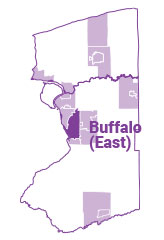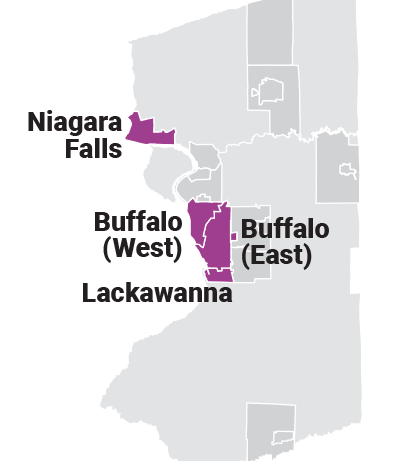Median Home Value, 2017
$61,588

About a quarter of all the individuals in or near poverty in the region live east of Main Street in Buffalo. While improved high school graduation rates and safer neighborhoods strengthen the community, challenges persist. The community has relatively high rental costs, low household incomes, and limited educational attainment.
Click here to learn more about what living in or near poverty means for individuals and families.
Vulnerable populations, % living in poverty, 2017
Source: American Community Survey.
Source: American Community Survey.
Source: American Community Survey.
Source: American Community Survey.
Source: American Community Survey.
Source: American Community Survey.
| Rank | Employer |
|---|---|
| #1 | Buffalo General Hospital |
| #2 | Roswell Park Comprehensive Cancer Center |
| #3 | Erie County Medical Center |
| #4 | Buffalo City School District |
| #5 | University at Buffalo |
| #6 | Sisters of Charity Hospital |
| #7 | Buffalo VA Medical Center |
| #8 | Mercy Hospital of Buffalo |
| #9 | Niagara Frontier Transportation Authority |
| #10 | Lactalis |
Source: Various. See Data Sources and Notes.
| Buffalo East | Buffalo Niagara | |
|---|---|---|
| Total Jobs | 53,924 | 547,851 |
| <$15k/yr | 10,436 (19%) |
150,324 (27%) |
| $15k-$40k/yr | 18,325 (34%) |
178,599 (33%) |
| >$40k/yr | 25,163 (47%) |
218,928 (40%) |
Source: American Community Survey.
$61,588
$707/mo



Over 200 human service providers and leaders use Numbers in Need to find information, build partnerships, pursue funding and advocate for their community.
“This data has been instrumental in finding what our community looks like and what obstacles we need to tackle to move ahead.”
“I have repeatedly and often share this data with colleagues and community members.”